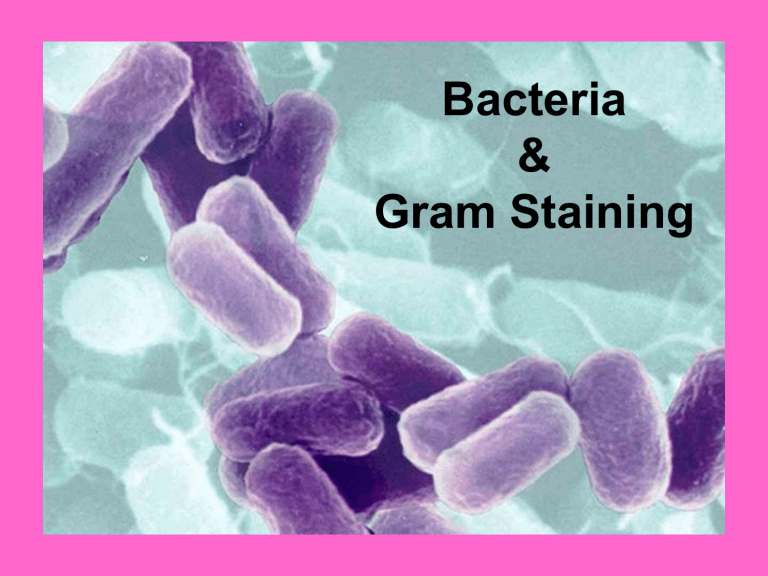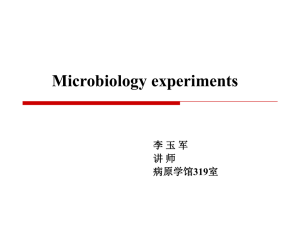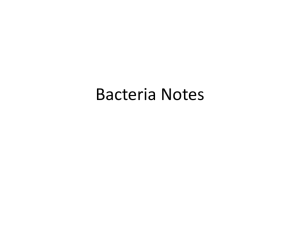Bacteria & Gram Staining

Bacteria
&
Gram Staining
Origins -
Three Domain Classification
EU
PROKARYOTES
Prokaryotes & Eukaryotes
Prokaryotic Cells Eukaryotic Cells
Genetic Material DNA not bound by membrane; DNA usually a singularly circular chromosome
Organelles Lacks membranebound organelles
Cell Wall
Cell Division
Cell walls contain peptidoglycan
Usually Binary
Fission
DNA found in a nucleus; DNA contained in multiple chromosomes
Contains membrane-bound organelles
Cell walls are usually chemically simple
Mitosis
Origins
First formed about 3.5 billion years ago
FIRST LIFE FORMS WERE Archaea, or ancient bacteria
Eubacteria is true bacteria
(Eu = true)
Eukaryote = true nucleus
Archaea
• Primitive bacteria
• Live in extreme or harsh environments
• 3 kinds:
– Halophiles = live in very basic or salty environments
• Great Salt Lake
• Dead Sea
– Methanogens = don’t require O
2 methane gas (CH
4 to live, make
) as product of respiration
– Thermophiles = live in hot or acidic environments (~pH 1-4)
• Near undersea volcanic vents
• Sulphur Springs
• Hot springs in Yellowstone National Park
Eubacteria
Ubiquitous = they exist everywhere
Harmful – pathogenic (they cause disease)
Helpful – they have a variety of uses
Bacterial Uses!!
• Food & Drink Production
– Fermentation (drinks)
– Baking (Baker’s yeast)
• Sewage Decomposition
– Bacteria break down the organic matter
• Nitrogen Fixation in roots
– Helps plants take up H
2
O and nutrients from soil
Bacterial Uses!!
• Mining
– Bacteria concentrate desired elements from ore
• Bioremediation
– Microbes can help repair damaged ecosystems
• Human Recreation = Artificial Snow-Making
– Bacteria allow H
2
O to form ice crystals
Bacterial Classification
1.
Shape and Groupings
2.
Cell wall composition
3.
Environment
4.
DNA Sequences
Bacterial Cell
Bacterial Structure
Cell Wall
Prevents cell from rupturing
Composition of cell wall helps to identify bacteria
Cell Membrane
F(x) = support & protect
Differentially permeable
Cytoplasm
Contains organelles (non-membranous)
Bacterial Structure
Genetic Material
Single, circular chromosome
Plasmid = extra chromosome that can replicate separately from the main chromosome
•
•
Can be used as a vector for biological engineering
Can pass genes for antibiotic resistance onto other bacteria (sometimes resistance to several antibiotics @ one time)
Bacterial Structure
Ribosomes
F(x) is to synthesize proteins
Capsule (Slime Layer)
A viscous coating on the outside of a bacteria
Exterior to the cell wall
F(x)s:
•
Protection
•
•
Increases a bacteria’s pathogenicity (or ability to cause disease)
Protects bacteria from the Immune System
(WBC’s)
Bacterial Structure
Other structures (Appendages)
Flagella (protein appendage)
•
•
F(x) = locomotion
Cell can have one, two, or many
Pili (hair-like extensions)
•
F(x)s = attachment to host and transfer of genetic material
Fimbrae (shorter than pili)
•
F(x) = adhesion to surfaces
Flagella
Flagellar
Movement
Bacterial Shapes
Typical
Coccus/Cocci = spherical or round
Bacillus/Bacilli = rod-shaped
Spirillum/Spirilli = spiral-shaped
Spirochete = helical-shaped
Vibrio/Vibrios = curved rod
Coccobacillus = very short rod
Bacterial Shapes
Bacterial Shapes
Atypical
Pleiomorphic = vary in size and shape
Star-shaped
Rectangular or Cube-shaped
Mycoplasms = can change shape
Lack a rigid cell wall
Have a strong cell membrane
Bacterial Groupings
Groups determined by the plane in which the cell divides
Bacterial
Groupings
– 1 plane =
• diplo(pair)
• strepto(chain)
– 2 planes =
• tetrad (packet of 4)
– Several planes @ random =
• staphylo-
(grape-like clusters)
GRAM STAINING
• History & Definitions
– Developed by Hans Christian
Gram in 1884
– Used to help identify different typ es of bacteria (a differential stain)
– Stain uses differences in cell wall composition to differentiate between bacteria
– The most common/popular method for staining bacteria
– Can help determine which type of antibiotics will be most effective against a particular bacteria
Gram Positive Cells
• Stain purple
• Contain:
– A thick peptidoglycan layer + teichoic acids (cell wall)
– Sits on top of the plasma membrane
– This layer is permeable to small molecules
• More susceptible to Penicillin
Gram Positive Cell
• Stain pink/light red
• Contain (triple layer):
– A outer layer of lipopolysaccharides + outer membrane
(space)
– A thin layer of peptidoglycan
(space)
– A cell membrane
– Porin proteins in the outer membrane allow larger molecules to pass
• Less susceptible to Penicllin
Gram Negative Cell
Outer Layer
Cell Wall
Cell Membrane
Penicillin
• Antibiotic that inhibits the synthesis of peptidoglycan; used on actively growing organisms.
– Gram (+) cells Penicillin can get to the peptidoglycan layers
– Gram (-) cells Pencillin has a harder time attacking the peptidoglycan layers
– Some Penicillin derivatives can pass through the porin proteins of Gram (-) cells
Overview of Staining
Why do we stain?
•To better view a cell’s structure.
Gram Staining Procedure
Steps (abbreviated):
1) Add primary (1 o ) stain – Crystal Violet
2) Add mordant to cells – Iodine
3) Add decolorizer to cells – Alcohol
4) Add secondary (2 o ) stain - Safranin







